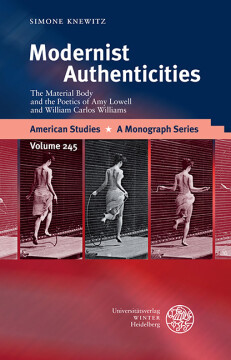
BUCH
Modernist Authenticities
The Material Body and the Poetics of Amy Lowell and William Carlos Williams
American Studies – A Monograph Series, Bd. 245
2014
Zusätzliche Informationen
Bibliografische Daten
Abstract
‘Modernist Authenticities’ challenges current understandings of modernism by investigating modernist poetry’s affinities with surfaces, performances, and materiality. Arguing that modernist writers reference the material body as a source of authenticity and anxiety, this study explores poetry in the context of somatic discourses. Reconsidering Amy Lowell’s and William Carlos Williams’s poetry, as well as texts by selected other authors, this book suggests that modernism operates with both essentialist and performative conceptions of authenticity. The study proposes that the expansion of the modernist canon in the last decades has still privileged the high modernist paradigm of originality. Authors like Williams and Lowell, who emphasize the theatrical and the performative, were relegated to the margins. Reading Williams’s and Lowell’s poems in relation to photography and film, expressive culture, and discourses of deviance, this book illuminates modernist literary practices in new ways.
Inhaltsverzeichnis
| Zwischenüberschrift | Seite | Aktion | Preis |
|---|---|---|---|
| Contents | 5 | ||
| Acknowledgments | 7 | ||
| Abbreviations | 11 | ||
| Introduction | 13 | ||
| Modernism and the Quest for Authenticity | 17 | ||
| Understanding Poems as Social Acts | 21 | ||
| The Body as a Source of Authenticity and Anxiety | 26 | ||
| Amy Lowell, William Carlos Williams, and the Canons of Modernism | 31 | ||
| 1 Poetry and Materiality: The Flower as Modernist Trope | 37 | ||
| “nature is not all red in tooth and claw”: The Victorian Culture of Flowers | 40 | ||
| The Language and Eroticism of Flowers in the Poetry of Lowell, T. S. Eliot, and H.D. | 44 | ||
| “Steel Roses”: Flowers in the Age of Mechanical Reproduction | 54 | ||
| Modern(ist) Flower Discourses and the Power of the Performative | 74 | ||
| 2 Authenticity, Presence, Voice: Modernist Formal Innovation and Early Twentieth-Century Expressive Culture | 77 | ||
| From the Expressive Culture Movement to Physical Culture | 80 | ||
| Spoken Art: Amy Lowell and S. S. Curry’s Theory of Expression | 85 | ||
| Poetry as Self-Expression? Authenticity, Presence, and Voice in Williams’s Al Que Quiere! | 101 | ||
| Authentic Expression and Natural Form | 113 | ||
| 3 Borderline Modernism: Sensation, Expression, and the Unconscious | 119 | ||
| Expression as Improvisation: The Performance of Immediacy in Kora in Hell | 121 | ||
| Black Bodies, White Subjects: Sensation and Expression in Borderline | 133 | ||
| Amy Lowell and the Senses of Modernism | 146 | ||
| 4 Techniques of the Observer: Formal Experimentation in Williams’s Voyeuristic Poetry | 151 | ||
| Spectacles of Deviance: “To Elsie” and Turn-of-the-Century Visual Representations | 152 | ||
| Observing the Observer: Williams’s Self-Reflective Voyeurism | 164 | ||
| “The supreme importance / of this nameless spectacle”: The Poet’s Gaze and the Bodies of Others in Spring and All | 171 | ||
| “Secret gardens of the self”: Diagnostic Encounters in the “Doctor Stories” | 182 | ||
| 5 Pictures of the FloatingWorld: Racial and Sexual Otherness in Lowell’s Enclosed Garden | 191 | ||
| The “Lacquer Prints”: Sex and the Floating World | 195 | ||
| “When we have shut and barred the door”: The Poetics of the Enclosed Garden | 203 | ||
| Lowell, Williams, and the Spectacle of the Other | 213 | ||
| Coda, Rethinking Modernism(s), Revisiting the Harlem Renaissance | 215 | ||
| Performing Authenticity: Modernism and the Material Body | 218 | ||
| Rereading the Harlem Renaissance | 223 | ||
| (Re)Turn to Presence: Modernist Poetry and Contemporary Theory | 226 | ||
| Works Cited | 231 |


 Publishing Platform by CloudPublish
Publishing Platform by CloudPublish